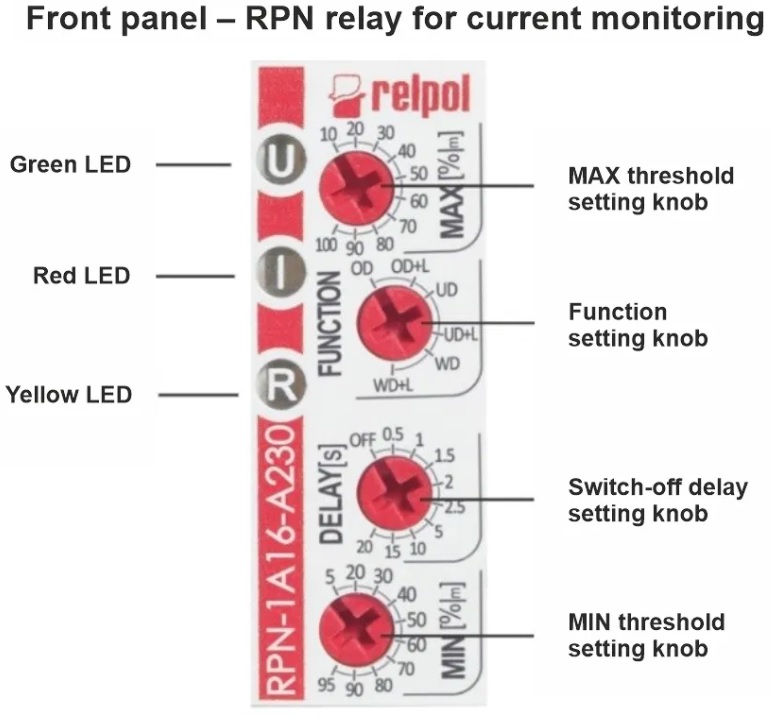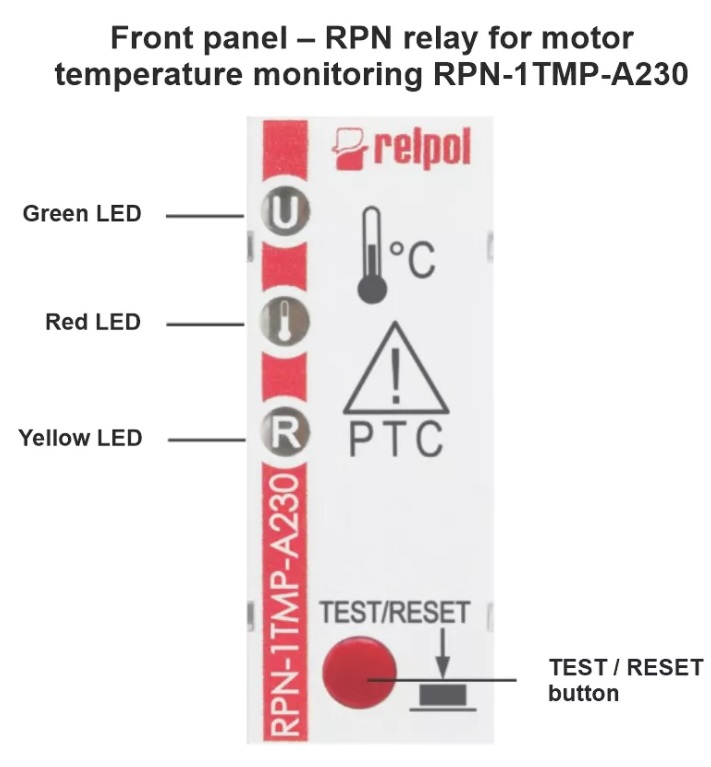Relpol relays available from TME
14.03.2022
Renowned manufacturer’s new products are now available in our catalogue.

- Relays – what are they and what’s their function?
- Relpol bistable (impulse) relays
- Relpol time relays
- Installation relays with high resistance to surge current
- RPN Relpol monitoring relays
- Relpol Push-in interface relays
A relay is a simple and reliable electrical device that finds use in all domains of our life, from household appliances in smart homes, to elaborate and powerful systems in production plants. One of the leading manufacturers of relays in our catalogue is a Polish company Relpol. This manufacturer offers a wide variety of components, and especially some of the categories are worth looking into.
Relays – what are they and what’s their function?
The use of time relays in an electrical system allows us to control the device or group of devices by opening and closing the circuit in sharp steps. In the case of a monitoring relay, if a certain value is exceeded, the signal fed to the relay triggers the response of the device, i.e. zero-one change of the output signal. To put it simple – it is responsible for the on/off function.
In the case of electromagnetic relays, the voltage applied to the relay coil, which indirectly causes change in relay’s contacts setup, can be the input signal that starts the component. In the case of the SSR relays, the input signal can be either voltage or current.
Relpol bistable (impulse) relays
The first category of products are bistable (impulse) relays RPB, made especially for lighting control in a building. They will be a good solution for both small houses and large facilities, such as production halls or hotels. The task of such a relay is to allow the control of lighting from different locations in the building, with a maximally simplified structure of the electrical system. Relays are fully compatible with building automation in general.
By allowing you to control the lighting from any place in the building, these products highly improve the comfort of use. Even with many light switches distributed around the building, the installation costs should be lower than in the case of traditional, complicated electrical installation. Additionally, the demand for power cables is lower. Another plus is the simplicity and speed of designing and laying such a system. Only one kind of cable is used (2-wire cable) and it is, as a rule, connected in parallel to the switch – this makes the installation process much easier and less prone to mistakes.
Relays with high resistance to surge current are Relpol’s latest addition. High resistance means that high values of starting (inrush) currents won’t be an issue for the relays. Relpol offers devices that are resistant to current as high as 120A (in 20ms) and 80A (in 20ms). In this series, the devices have various numbers of different types of contacts (1P, 2Z, 2x1P, 2x1Z). Relays come with or without memory and also as multifunctional – sequential relays. Below, you can see some examples of markings of the RPB series products.
1) High surge current relays:
- RPB-1ZI-... – relays from this series can resist up to 120A-strong surge currents in 20ms. They have one make contact, and thanks to their characteristics they can work with backlit buttons. According to manufacturer’s specification, the control voltage is: 230VAC, 24V AC/DC;
- RPB-1ZMI-UNI – this relay is equipped with the memory function. which is going to be described later in this article. It can resist surge currents up to 80A in 20ms. Just like its predecessor, it is equipped with one make contact. Its declared control voltage is: 12...240V AC/DC;
- RPB-2ZSMI-UNI – this relay has the current capacity of 2x16A. Moreover, the surge current resistance and voltage parameters are the same as for the model above.
2) Sequential relays – this solution allows for triggering a pre-set sequence by using just one switch.
- RPB-2ZSMI-UNI – this relay is equipped with the memory function and two make contacts. This model is resistant to surge current up to 80A in 20ms. Its standard control voltage is 12...240V AC/DC. The manufacturer states that its current capacity is 2 x 16A;
- RPB-2PSM-UNI – just like the model above, this is a sequential relay equipped with memory and with the same universal control voltage. It has two changeover contacts.
3) Memory relays – they are characterized by their ability to store the settings, even if a power outage occurs. The following models are worth mentioning:
- RPB-1PM-... – these relays are perfect for backlit buttons. For this kind of device the control voltage is 230VAC, 24V AC/DC.
- RPB-1PM-UNI – in this case, we are dealing with the control voltage of 12...240V AC/DC. Just like the model above, it is equipped with one changeover contact.
Relpol time relays
RPC time relays are the perfect solution in circuits that require the system to work with some delay. An example of such an application can be the AC system in a production hall. Because of frequent movement of the workers, the entrance door can’t always stay locked. In this situation, the AC is unable to do its job, as it can’t cool down the space that keeps getting warmed from the outside. That is when the relay comes to help, as it sends the signal to turn off the AC with some delay, and turns the system on again after the doors are closed.
Another important application of time relays can be to protect the device against too frequent, uncontrolled switching on. It can happen whenever there is a short signal that triggers the start. In that case, relay makes sure that the device turns on only when it’s really required.
Relpol time relays meet the highest global requirements when it comes to the quality and ergonomics of use. Made of properly selected materials, these relays can work with inductive loads, and a double hook makes the component easy to mount on a standard 35mm rail. In manufacturer’s catalogue we can find 36 different types that offer even 40 different time functions. Eight time intervals, from 1 second to 10 days with a smooth setting in the range from 0.1s to 1 x time range, ensure flexible control over the relay’s functioning. Relpol products use very low amounts of energy. The control voltage equals 12…240V AC/DC or 230V AC, depending on the model.
Relpol offers the following types of time relays:
- RPC-.MA and RPC-.MB multifunctional relays – with 10 time functions, e.g. delayed start, cyclical operation at symmetrical intervals, or switching on for a set time, among others. Relays are equipped with 1P and 2P contact configuration.
- Single-function relays – there are 12 relays with the most important and most used functions in the catalogue.
- Relays with additional STOP or RESET function – such solution is used depending on the process requirements.
- Relays that allow cyclical operating with two independent times. One of these models is RPC-1IP-UNI.
Surge current resistant installation relays
Relpol installation relays are designed to control the circuits that are heavily loaded with high inrush currents. This product is perfectly suited for high requirements of all kinds of lighting circuits. The ability to transfer high loads of surge currents protects the relay from damage. Relpol offers many kinds of installation relays. Some of these are:
1) RPI-1ZI-U24A – the maximum inrush current for this relay is 120A in 20ms. According to the manufacturer’s specification, this relay works really well with low power single phase motors, i.e. up to 650W.
2) RPI-1ZI-D12 – this relay is powered by 12V DC voltage. Its maximum inrush current is the same as for the model above (120A in 20ms). It can be used in switchboards of modular devices.
It must be mentioned that different relays are selected for different types of lighting, according to the manufacturer’s data on power consumption during the switching on of the light source.
These relays are commonly used in the following applications:
- Building automation (e.g. residential buildings and hotels) – for controlling the lighting circuits (switching the lights on and off). Such circuits are equipped with time programmers and control buttons.
- Industrial automation – for the control cabinets and switchboards responsible for controlling circuits loaded with high surge currents. In the case of huge industrial machines, relays without an appropriate resistance to inrush current would get damaged quickly.
RPN Relpol monitoring relays
Monitoring relays are responsible for the control of current, voltage and temperature to protect the device from exceeding the acceptable value and potential damage.
The manufacturer offers two kinds of relays from the new series:
1) Relays for monitoring AC current in a single-phase system
The current monitored by these relays is 0.5÷16A, which means they are as if tailor-made for each circuit. According to manufacturer’s data, the relays are equipped with three current controlling functions. They can monitor the current’s maximum and minimum values, or they can monitor the current in a narrow range and shut it down if needed.
The range of the time delay setting is 0.5÷20 seconds, and the current range is:
- 10÷100% for maximum current;
- 5÷95% for minimum current.
These relays can have an additional error memory function. In the case of an error, this solution automatically shuts down the relay, which remains turned off until the current inflow caused by the user stops and starts again. Only the “memory reset” can trigger a signal for the relay to work automatically again.
Controlling the device is very simple and intuitive. All you have to do is set the knob in a right position, according to your needs. Below, you can see the RPN monitoring relay’s front panel.

2) Relays monitoring the motor’s operating temperature
The monitoring relay is the best solution that can stop the motor to protect it from overheating. One of the models available from TME is RPN-1TMP-A230. This relay is able to monitor the electromagnetic coil’s temperature by measuring the PTC sensors’ resistance. When the maximum value of resistance is exceeded, the relay shuts the motor off and turns on a diode to signal the error’s occurrence. At the same time, the relay pre-emptively protects the sensor circuit from short-circuit. The device is equipped with a button that releases the relay and resets the memory to remove the error.
Below, you can see aforementioned relay’s front panel.

Another solution for electric motor protection is to monitor voltage fluctuations in a three-phase network. The relays disconnect the contact when the maximum voltage value is exceeded. RPN-1V models are flagship products from this series. The two relays showcased below differ in terms of disconnection time. RPN-1VFT-A400 relay can be set in the 1÷9 seconds range, while the RPN-1VFR-A400 relay has a fixed, non-adjustable time of safe operation.
The relays protect the installation from unwanted occurrences, such as phase failure or asymmetry. Some of the models are also able to control the phase order.

Relpol push-in interface relays
The sets of push-in interface relays are one of the most interesting solutions. You can install and remove such relays very intuitively and quick. Additionally, their measurement function is highly improved thanks to special probe slots that allow for greater probe stabilization. Relpol relays are equipped with suitable space for permanent marking, where the user can place a label with a description. This makes even the most complicated system with many electrical circuits clear and easy to identify.
Interface relays and push-in sockets are equipped with special buttons that release the clamp, which allows for easy installation and removal of the socket cables.
Push-in interface relays stand out among traditional solutions thanks to a wide array of contacts and bridges. Thanks to them, large groups of products can be connected quickly, with unlimited possibilities of multiplication of shared signals. Connection possibilities:
- Bridging a few relays with an identical power supply potential, which allows for the creation of various connections;
- Design of sockets allows for bridging the COM clamps in the neighbouring sockets using dedicated double-pole connectors;
- Creating parallel output connections for redundant systems using dedicated double-pole connectors;
- Fast and safe distribution of power to the coils of large groups of relays using insulated plug-in eight-pole relays. These connectors don’t require any tools in order to shorten them, as they have special points that allow for precise manual breaking.
These relays, thanks to their characteristics, meet the high requirements of the industry. The GZP80 and GZP4 series sockets are the flagship models of sockets, designed especially for the needs of industry and automation, and also the base for push-in relays. The aim is to simplify the installation and wiring of the relays and to allow for easy and quick diagnostics, as well as to enable the permanent labelling of the products.
Text prepared by Transfer Multisort Elektronik Sp. z o.o.
The original source of text: https://www.tme.eu/en/news/library-articles/page/44363/relpol-relays-available-from-tme/





































